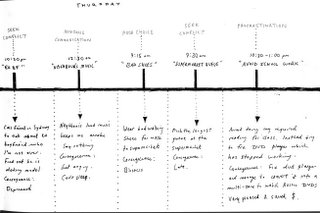SELF-SABOTAGE
For a 72-hour project involving changing one's interface to and behaviour within the world - I opted for calculated and exaggerated acts of self-sabotage. I selected this as I suspected it was an innate personal tendency anyway - and was curious to see what would happen when I more methodically pursued this instinct. It forced me to first think about how my own interface could be altered to render every situation/experience to become as stressful, unproductive, and futile as possible. I realised it would be my own words, actions and choices that would fuel this sabotage. Once it began, I also noticed strategies that were more effective than others. The more pro-active I behaved, the better. Rather than seeking out people who were having an argument to get involved in, I would initiate that argument and see how much negativity could spiral from that first act of self-sabotage. It was also useful to classify different methods I was unconsciously employing in the service of self-sabotage. I realised I was devising a real system through which to generate self-sabotage in my own life.


REFLECTIONS
After presenting and receiving feedback from the class - I began to think about what self-sabotage can mean to a graphic designer, and what it can mean to my own working methodologies. As a graphic designer, I usually move through steps of the design process impelled by intuition, what I have researched, what I see before me, and the client's needs. It is the area of intuition that I have begun to pick apart while at grad school - and consider how much of this falls within one's own personal comfort zone.
This project forced me to artificially work against better instinct. But in doing so, I observed my instinct is often tinged by a hint self-sabotage anyway - part of me enjoys picking the choice that seems most absurd, forcing myself to work within ridiculously narrow constraints, or with seemingly inappropriate visual metaphors. What visual outcomes result from working in this way? Often such self-sabotage can stop you dead in your own tracks, paralysed by the difficulties one has actually created for oneself. Personally though, I think there can be a resulting tension/friction from making things a little difficult that actually can lead to unforeseen outcomes. I personally like work that seems to be fighting somewhat within itself, to make sense of itself, to make an audience make sense of itself. This makes me consider; are there any physical remnants of this process in the visual outcomes? Can self-sabotage as a working method leave a mark on work that is visible or at least palpable to the audience? Can this tendency be harnessed and used to push myself out of my own comfort zone?
For a 72-hour project involving changing one's interface to and behaviour within the world - I opted for calculated and exaggerated acts of self-sabotage. I selected this as I suspected it was an innate personal tendency anyway - and was curious to see what would happen when I more methodically pursued this instinct. It forced me to first think about how my own interface could be altered to render every situation/experience to become as stressful, unproductive, and futile as possible. I realised it would be my own words, actions and choices that would fuel this sabotage. Once it began, I also noticed strategies that were more effective than others. The more pro-active I behaved, the better. Rather than seeking out people who were having an argument to get involved in, I would initiate that argument and see how much negativity could spiral from that first act of self-sabotage. It was also useful to classify different methods I was unconsciously employing in the service of self-sabotage. I realised I was devising a real system through which to generate self-sabotage in my own life.


REFLECTIONS
After presenting and receiving feedback from the class - I began to think about what self-sabotage can mean to a graphic designer, and what it can mean to my own working methodologies. As a graphic designer, I usually move through steps of the design process impelled by intuition, what I have researched, what I see before me, and the client's needs. It is the area of intuition that I have begun to pick apart while at grad school - and consider how much of this falls within one's own personal comfort zone.
This project forced me to artificially work against better instinct. But in doing so, I observed my instinct is often tinged by a hint self-sabotage anyway - part of me enjoys picking the choice that seems most absurd, forcing myself to work within ridiculously narrow constraints, or with seemingly inappropriate visual metaphors. What visual outcomes result from working in this way? Often such self-sabotage can stop you dead in your own tracks, paralysed by the difficulties one has actually created for oneself. Personally though, I think there can be a resulting tension/friction from making things a little difficult that actually can lead to unforeseen outcomes. I personally like work that seems to be fighting somewhat within itself, to make sense of itself, to make an audience make sense of itself. This makes me consider; are there any physical remnants of this process in the visual outcomes? Can self-sabotage as a working method leave a mark on work that is visible or at least palpable to the audience? Can this tendency be harnessed and used to push myself out of my own comfort zone?
0 Comments:
Post a Comment<< Home